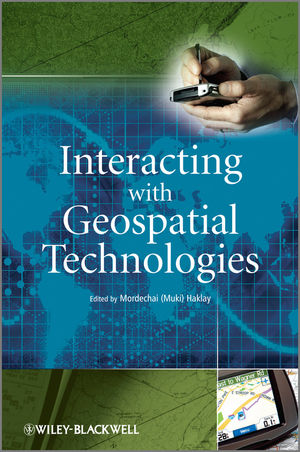Interacting with Geospatial TechnologiesISBN: 978-0-470-99824-3
Hardcover
312 pages
May 2010
 This is a Print-on-Demand title. It will be printed specifically to fill your order. Please allow an additional 10-15 days delivery time. The book is not returnable.
|
||||||
About the authors.
How to use this book.
Acknowledgements.
SECTION I THEORY.
1 Human-computer interaction and geospatial technologies – context Mordechai (Muki) Haklay and Artemis Skarlatidou).
1.1 Human-computer interaction and usability engineering background.
1.2 Geographic Information Systems and science history.
1.3 Human-Computer Interaction and GIScience research.
Summary.
Further reading.
Revision questions.
2 Human understanding of space (Clare Davies, Chao (Lily) Li and Jochen Albrecht).
2.1 Introduction.
2.2 Spatial cognition: screen versus geography.
2.3 Geographic spatial cognition – learning, understanding and recall.
2.4 GIS in the outside environment: matching maps to geography.
Summary.
Further reading.
Revision questions.
3 Cartographic theory and principles (Catherine (Kate) Emma Jones).
3.1 Principles of cartographic representation.
3.2 Impact of projections on map design.
3.3 Impact of cartographic scale on map design.
3.4 Generalization.
Summary.
Further reading.
Revision questions.
4 Computer-mediated communication, collaboration and
groupware (Mordechai (Muki) Haklay).
4.1 Computer-mediated communication.
4.2 Social dynamics and group decision-making issues.
4.3 Computer Supported Collaborative Work and Groupware (CSCW).
4.4 Principles of collaborative GIS.
Summary.
Further reading.
Revision questions.
SECTION II FRAMEWORK.
5 User-centred design (Mordechai (Muki) Haklay and Annu-Maaria Nivala).
5.1 Background.
5.2 Principles.
5.3 Applying user-centred design in geospatial technologies.
5.4 Participatory design.
Summary.
Further reading.
Revision questions.
6 Usability engineering (Mordechai (Muki) Haklay, Artemis Skarlatidou and Carolina Tobón).
6.1 Background.
6.2 Usability engineering and product development process.
6.3 Understanding user requirements and needs.
6.4 Application development.
6.5 Evaluation and deployment.
6.6 Usability engineering in research.
Summary.
Further reading.
Revision questions.
SECTION III PRACTICALITIES AND TECHNIQUE.
7 Application planning (Jochen Albrecht and Clare Davies).
7.1 GIS interface complexity.
7.2 Task analysis in GIS.
7.3 Formalized analysis of GIS user interfaces.
7.4 User experience considerations.
7.5 Task analysis as the basis for workflow management.
7.6 Geo-scientific workflows and process models.
7.7 Ontologies in support of application planning for the
semantic web.
Summary.
Further reading.
Revision questions.
8 Practical cartography (Catherine (Kate) Emma Jones).
8.1 The role of symbology in map making.
8.2 The role of colour in map making.
8.3 Data classification – types of maps and thematic mapping.
8.4 Mapping conventions – map elements and layout.
Summary.
Further reading.
Revision questions.
9 Principles of interaction (Jessica Wardlaw).
9.1 Key elements of the theory of interaction for geospatial technologies.
9.2 Basic elements of GUI.
9.3 Some guidelines for designing a GIS interface.
Summary.
Revision questions.
10 Evaluation and deployment (Stephanie Larissa Marsh and Mordechai (Muki) Haklay).
10.1 Evaluation options – from usability laboratory to guerrilla usability.
10.2 Evaluation techniques.
10.3 Methodological consideration of usability techniques.
Summary.
Further reading.
Revision questions.
11 Single user environments: desktop to mobile (Mordechai (Muki) Haklay and (Lily) Chao Li).
11.1 Technological considerations.
11.2 Understanding the user context.
11.3 Designing desktop applications.
11.4 Mobile devices.
Summary.
Further reading.
Revision questions.
12 Web-mapping applications and HCI considerations for their
design (Artemis Skarlatidou).
12.1 Overview of Web-mapping.
12.2 Web-mapping design and HCI considerations.
Summary.
Further reading.
Revision questions.
Bibliography.
Index.



